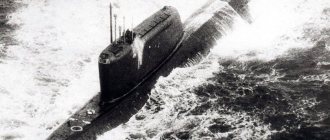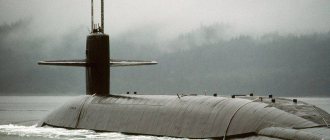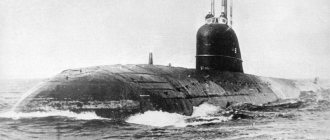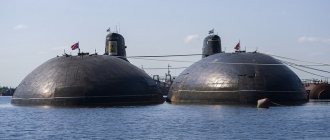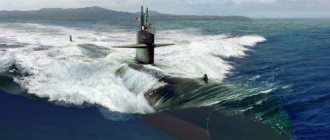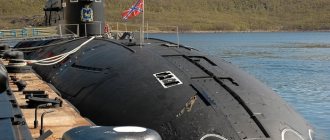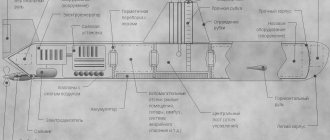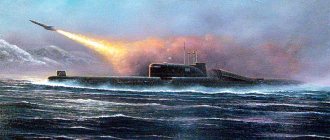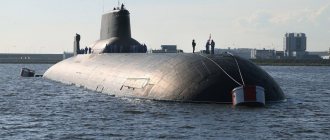Brief history of creation
The term “arms race” can be understood almost literally - both countries were chasing each other in an effort not to lag behind and to prevent even the slightest superiority of their potential enemy. This was especially true for strategic weapons, which included nuclear submarines. Work on the creation of the Soviet submarine Project 667 began in 1958 in response to the American Project Lafayette, which envisaged the implementation of a large-scale program to create a series of submarines equipped with nuclear weapons. By analogy with the Americans, each Soviet missile submarine was supposed to have 16 launchers. During the design work, the initially conceived design, which involved mounting missiles outside the hull and equipping the boats with rotating devices that transfer the missiles from the traveling to the firing position, was rejected and replaced with vertical launch silos located inside the durable hull of the boat.
The path to creating submarine missile carriers
In the early 80s, the arms race pushed engineer Viktor Makeev, a student of Sergei Korolev, to create a unique naval liquid-fuel rocket with a range of 2,500 km.
For the first time, it made it possible to attack targets without floating to the surface of the water. It was decided to arm the missile carriers with these weapons, which received code 667. Few people know that initially the designers proposed placing 8 missiles on the sides of the submarine in a horizontal position. Before launch, twenty-ton products had to be turned 90 degrees. A model of such a submarine was even made to show it to General Secretary N. S. Khrushchev. But at the most crucial moment, the demonstration device failed, and Khrushchev caustically ridiculed the designers. Without knowing it, he saved the submariners from the most difficult pre-launch operation under water. After this, chief designer Sergei Kovalev insisted on a vertical arrangement of missiles inside the body in two rows. This scheme made it possible to double the ammunition load and became a classic in world shipbuilding.
On July 4, 1965, in Yalta, the new head of the country, Leonid Brezhnev, for the first time listened to the Minister of Shipbuilding about the prospects for the development of the industry. The topic of lagging behind the United States was so important that the chief designer of submarines, Sergei Kovalev, was invited to the meeting. He was able to convince the country's top leadership of the reality of creating a nuclear submarine with 16 ballistic missiles. Brezhnev immediately ordered the drawing up of a work plan for shipbuilders for 10 years in advance and provided unlimited funding.
The design and development of working drawings of the lead submarine missile cruiser K-137 was carried out at the Leningrad design and installation bureau "Rubin". Construction was carried out at the Northern Machine-Building Enterprise. The enterprise's many-thousand-strong team under the leadership of E.P. Egorov established large-scale construction of nuclear-powered missile carriers and made a great creative contribution to the creation of formidable military equipment for the USSR Navy.
Construction of the first submarine
The timing of the construction and testing of the first sample of the Project 667 submarine is amazing. It received the designation Project 667A. Having been laid down in the slipway in Severodvinsk at the end of 1964, she was launched in August 1966, and entered service the following year. The submarine was named "Leninets" and received the designation K-137. Currently, such rates are unthinkable, even for conventional surface ships, not to mention submarines, which often take decades to build.
Mass production
The development of the production of Project 667 submarines was also carried out at an accelerated pace. The boats were produced at two factories, in Severodvinsk and Komsomolsk-on-Amur. The pace of production was also impressive. In 1967, one boat was put into service, in 1968 - already four, and a year later - five. Since 1969, a plant in the Far East has also been connected to Severodvinsk. The Soviet Union was once again trying to catch up with the Americans, who had already built 31 nuclear submarines by the end of the 60s.
Design
The Project 667 submarine had a traditional double-hull design for that time, the depth control surfaces were located on the wheelhouse, and the missile silos were located behind the wheelhouse in the hull. The nuclear-powered submarine was armed with 16 launchers with R-27 ballistic missiles, equipped with nuclear warheads of 1 megaton each and a range of 2,500 km. The power plant was represented by two autonomous units with a total power of 5200 horsepower, which made it possible to develop an underwater speed of up to 28 knots. An interesting fact: the Americans, who did not expect such “agility” from Soviet industry, gave the unofficial name to this boat “Yankee”. In our fleet, the nuclear submarine “Azuha” of Project 667 also received its unofficial name, apparently because of the abbreviation AZ - automatic protection device, first introduced on this boat.
History of the creation of strategic nuclear submarine cruisers Project 667B "Murena"
From “Navaga” to “Murena”: Soviet submarine missile cruisers of the new generation
In the 1970s, the Sosus system was put into operation in the United States, which is a huge system of hydroacoustic antennas located underwater along the entire North American coast, as well as means for automated processing of noise direction finding signals at coastal computer centers. In the face of such opposition, it became almost impossible for Soviet submarines to easily get within range of a missile salvo from the enemy.
It was possible to “nullify” the American “Sosus” in only one of two ways: either to make the submarine missile carriers as silent as possible, or to increase the distance of the missile salvo, or better yet, to combine both approaches “in one bottle.”
This is how the program for the construction of new nuclear missile submarines emerged, which are a further development of the 2nd generation submarines of the 667th project. The working name of the project was the code: Project 667B “Moray eel” .
The basis of the armament of the new missile cruisers was the D-9 missile system , which has a range three times greater than that of the existing D-5/D-6 missile system, equipped with an on-board azimuthal astro-correction system, which makes it possible to clarify the position of the missile in space using the stars and correct the direction of its movement.
Not only the characteristics of the firing range have improved, but also the time for pre-launch preparation of missiles has been reduced by five times, and, most importantly, now the entire ammunition load of a missile carrier can now be fired in one salvo.
Increasing the combat capabilities of the D-9 missile system had to be paid for by increasing the mass and dimensions of the missile. Compared to the “old” R-27 ballistic missile, the length of the “new” R-29 has increased by 40%, the body diameter has increased by 20%, and the launch weight has doubled. As a result, in order to “shove” the new complex into the existing hull of the boat, it was necessary to reduce the number of missile silos from 16 to 12.
However, even with such a “reduced” arsenal, a missile cruiser equipped with the D-9 complex was 2.5 times superior in combat effectiveness to a similar ship armed with the D-5 complex.
Project 667B nuclear-powered missile submarine Murena. The volumetric “hump” of missile silos behind the submarine’s conning tower is clearly visible
Commissioning of Project 667B “Murena” strategic nuclear submarine cruisers and comparison with American counterparts (C-3 “Poseidon”)
The tactical and technical specifications for a nuclear submarine equipped with the D-9 missile system were approved in 1965. The development of the ship, which received the project number “667B” and the code “Moray”, was carried out at the Rubin Central Design Bureau for MT under the leadership of chief designer S.N. Kovaleva.
Work on creating a missile carrier proceeded at a fairly fast pace, even ahead of the time frame for creating the main weapon of the submarine - the D-9 missile system. As a result, test launches of ballistic missiles began after the lead ship of the series was commissioned. Officially, the D-9 missile system was put into service only on March 12, 1974.
The construction of a series of 18 nuclear submarines of Project 667B "Murena" was carried out at the Sevmash enterprise in Severodvinsk, where 10 submarine missile cruisers were built, as well as at the plant named after. Lenin Komsomol (Komsomolsk-on-Amur), which built 8 more ships.
If we compare the capabilities of the D-9 missile system with its contemporary American missile system, the Poseidon S-3, which entered service with the United States almost at the same time, then with approximately the same launch weight (29.5 tons), the American missile as standard had maximum range of only 4600 km, that is, inferior to the R-29 by 60%.
The Poseidon launch depth was 15-30 m, while the Soviet rocket could launch from a depth of 55 meters. Despite the fact that both American and Soviet submarines could fire their entire ammunition in one salvo, the American complex had a longer launch preparation time (about 15 minutes) and a significantly longer interval between missile launches (about one minute).
At the same time, the accuracy characteristics of the American missile from the Poseidon complex were significantly higher, however, given that both missiles were equipped with a separable warhead and were not intended for an accurate strike, but to “cover” an object over an area, this parameter was not critical.
Project 667B nuclear-powered missile submarine Murena, rear view.
Development of the design
In the early 70s, within the framework of the logic of the arms race, the United States introduced a fairly effective hydroacoustic location system for submarines, which made the location of Soviet submarines on combat duty off the coast of North America clearly visible. As a result, it became necessary to move the boundaries of combat duty away from the shores of a potential enemy, but this required increasing the range of missile weapons. This is how Project 667 B submarines appeared, which received the designation “Moray”.
These submarines were equipped with R-29 missiles, which had an intercontinental firing range and, unlike the R-27, were two-stage. The rocket had significantly larger dimensions. Accordingly, the design of the submarine was changed. The length and especially the height of the boat increased somewhat due to the characteristic protrusion behind the wheelhouse, similar to a hump. Of the previously available 16 missiles, only 12 remain, but with a higher charge power.
Nuclear submarines with ballistic missiles. Project 667-B "Moray eel" (Delta-I class)
The military shipbuilding plan of 1969-1980 provided for the creation of a nuclear missile stable strategic underwater system with long-range weapons, which would complement the land-based ICBMs, which at that time formed the basis of the Soviet nuclear missile arsenal. This decision was largely determined by the creation in the United States of a powerful sonar detection system for USSR submarines along their transit routes. All this created serious problems for our submarine forces, which could be solved by reducing the noise of nuclear submarines with ballistic missiles and changing the combat patrol areas of submarines. As part of the shipbuilding program, it was planned to create new submarine nuclear missile carriers, which were a further development of the second generation submarines of Project 667-A.
The development of domestic 2nd generation strategic submarine missile carriers was carried out mainly in the direction of increasing the range of their missile weapons. The D-9 missile system, in development since 1963, was supposed to have a range three times greater than the D-6. The navigation system installed on the submarine did not provide the necessary accuracy of firing the missile, which has an inertial guidance system. As a result, Makeev’s design bureau, together with the leadership of NPO Geophysics, NIIAP and NIIA, decided to develop an on-board azimuthal astro-correction system, which makes it possible to clarify the position of the rocket in space based on the stars and correct the direction of the rocket’s movement. Further improvement of the missile fire control system made it possible to reduce the pre-launch preparation time by five to seven times, as well as ensure the launch of the entire ammunition load in one salvo.
The opportunity to increase the combat capabilities of the missile system was paid for by increasing the dimensions and weight of the missile. Compared to the R-27 missile, the length of the new ballistic missile has increased by 40 percent, the diameter has increased by 20 percent, and the launch weight has doubled. As a result, in order to install a new complex in the existing submarine hull, the number of missile silos was reduced from 16 to 12. But, as calculations showed, the use of the D-9 missile system increased the efficiency of the Project 667 missile cruiser by 2.5 times. The specifications for a nuclear submarine equipped with the D-9 complex with R-29 ballistic missiles were approved in 1965. The development of the submarine, which received project number 667-B (code "Murena"), was carried out by the Central Design Bureau of Marine Equipment "Rubin". Project manager - chief designer Kovalev S.N.
Work on the creation of a missile carrier was carried out at a fairly fast pace, which was somewhat ahead of the time frame for creating missile systems. As a result, experimental launches of the ballistic missile began after the lead ship of the series entered service. The missile system was officially put into service only on March 12, 1974. The complex included 12 liquid-fueled two-stage ampuled missiles R-29 (according to the agreement - RSM-40, ind. GRAU - 4K75, NATO designation SS-N-8 “Sawfly”). The maximum firing range of the R-29 is 7.8 thousand km. This missile became the first Soviet naval missile equipped with the means to overcome enemy missile defenses. When folded, light decoys were placed in cylindrical special ones. containers that are welded into the second stage fuel tank.
The design of the Project 667-B Murena nuclear-powered ballistic missile submarine (NATO designated Delta-I class) mainly repeated the design of its predecessor, the Project 667-A Navaga nuclear submarine. The double-hull submarine, slightly longer than Project 667-A, had a durable hull and was divided into ten watertight compartments. The greater length of the missiles caused the height of the fairing of the missile silos to increase, and the silhouette of the boat acquired a characteristic “hump” - an identifying feature of Project 667-B submarines and their later modifications. The main power plant included two nuclear water-cooled reactors VM-4B with OK-700 PPU, as well as two steam turbines with GTZA-635 turbo-gear units. There were two DG-460 diesel generators, as well as two economical electric motors. To reduce the hydroacoustic signature of the vessel, a two-stage damping of the vibration-active mechanisms of the steam turbine plant was introduced.
Longitudinal section of APKR project 667B:
1 - main antennas of the Kerch State Joint Stock Company; 2 — tank for bubble-free torpedo firing; 3 - 533 mm TA 4 - annular gap tank; 5 — torpedo replacement tank; 6 — bow hatch; 7 — bow emergency buoy; 8 — spare 533 mm torpedoes; 9 — torpedo loading hatch; 10 — bow (torpedo) compartment; 11 — nasal group AB; 12 - hydrodynamic log; 13 — Central City Hospital; 14 — capstan and capstan machine; 15 — VVD cylinders; 16 - second (living) compartment; 17 — aft group AB; 18 — closed navigation bridge; 19 — gyrocompass repeater; 20 — periscope of the MT-70-8 system; 21 — periscope PZNG-8; 22 — conning tower; 23 - third (central) compartment; 24 - central post; 25 — periscope of the “Volna” astrocorrector; 26 — radio sextant “Saiga”; 27 — direction finder antenna “Zavesa”; 28 — radar antenna; 29 — RDP; 30 — SORS “Zaliv-P” antenna; 31 — fourth (bow missile) compartment; 32 — missile silo; 33 - fifth (aft missile) compartment; 34 emergency fuel drain pump room; 35 — VVABT “Paravan” and its winch; 36 — sixth (auxiliary mechanisms) compartment; 37 — diesel fuel tanks; 38 - seventh (reactor) compartment; 39 - reactor; 40 — steam generator; 41 - heat exchange block; 42 — receiver cylinders; 43 — eighth (bow turbine) compartment; 44 - steam turbine; 45 - capacitor; 46 — elastic coupling; 47 - planetary gearbox; 48 — main thrust bearing (GUP); 49 — oil cooler; 50 — ninth (aft turbine) compartment; 51 — condenser electric pump; 52 — autonomous turbogenerator (ATG); 53 — pop-up camera (VSK); 54 — aft hatch; 55 — rowing ED (GED); 56 — elastic coupling; 57—tenth (aft) compartment; 58 — stern emergency buoy; 59 — stern rudder drives
The submarine was equipped with the new Tobol-B navigation system, which included the equipment of the Cyclone-B space navigation system. The complex provided all the initial data necessary for preparing and launching missiles.
Radio communication equipment, installed on earlier designs of nuclear submarines and being a set of different systems, was integrated into the Molniya-L complex for the first time on the new submarine. On the new nuclear-powered ship, as well as on the nuclear-powered ships of Project 667-A, the Kerch hydroacoustic complex was installed in the bow. The vessel received a new BUIS "Almaz". On Project 667-B, for the first time on Soviet submarines, the autonomous shipborne digital computer system (KTSVS) “Alpha” was used to control missile weapons, which solved the problems of missile fire. The entire submarine's missile ammunition could be fired in one salvo. For the first time in the world, a missile protection system against unauthorized action has been created for nuclear submarines with Project 667-B ballistic missiles. The missiles could be launched only after an order was received from the High Command. Missiles could be launched from an underwater position from depths of up to 55 meters with a sea state of less than 6 points and a ship speed of up to 5 knots, not only with single missiles, but also with a salvo of the entire ammunition load. Missile firing from the surface was allowed while the submarine was in the base (this possibility was ensured by the intercontinental range of the missile). Both the pre-launch preparation of the missiles and the firing of the shot were carried out in automatic mode. If the latitude of the launch point for the D-5 complex was limited to 85 degrees, then the D-9 complex became the first all-latitude missile system in the world.
In the bow of the submarine there were four torpedo tubes of 533 mm caliber, the total ammunition of which was 12 missile torpedoes or torpedoes, as well as 2 torpedo tubes of 400 mm caliber for anti-submarine small-sized torpedoes and MG-44 - self-propelled hydroacoustic countermeasures.
Modifications of Project 667-B
In 1978, the modernized D-9D missile system with improved R-29D intercontinental ballistic missiles (NATO designation - SS-N-8 mod.2) entered service with the fleet. The range of this missile was increased to 9.1 thousand km, and the accuracy was also increased (CEP of about 1000 meters). The D-9D complex was installed on several Project 667-B submarines during their overhaul and modernization. The next modernization of the complex was carried out in 1986.
In June 1972, the Rubin Central Design Bureau was issued a TTZ for the development of an improved version of the submarine capable of carrying 16 R-29 missiles. An additional four missiles were released in a second, independent missile salvo. The new nuclear-powered vessel was assigned project number 667-BD, code "Murena-M" (NATO designation - Delta-II). Initially, the submarines were armed with the D-9D missile system with R-29D missiles.
Project 667-B submarine construction program.
Construction of a series of eighteen nuclear submarines of Project 667-B was carried out in Severodvinsk at the Sevmashpredpriyatie, where 10 SSBNs were built, and in Komsomolsk-on-Amur at the plant named after. Lenin Komsomol, which built 8 ships. The first hull at Shipyard No. 402 was laid down in 1969, launched in 1971 and put into operation in 1972. The last two submarines, created in Komsomolsk-on-Amur, entered the fleet in 1977.
Modified Project 667-BD submarines were produced only in Severodvinsk (4 units). The first nuclear submarine with a ballistic missile, modified according to this project, entered service in 1975.
Status of Project 667-B boats for 2007.
K-279, the lead ship of this project, entered service with the strategic submarine division of the Northern Fleet in 1972. This division was based in Yagelnaya Bay. Also in 1972, it was decided to form the 41st division, equipped only with Project 667-B vessels. The new unit was relocated to Gremikha in 1974, joining the eleventh submarine flotilla. In the Pacific Fleet, Murena submarines became part of the twenty-fifth division of strategic submarines based in Kamchatka. Some of the strategic missile cruisers were transferred to the Pavlovskoye base in Primorye in the late 1970s. The combat patrol zone of Project 667-B submarines of the Northern Fleet, as a rule, was located between Novaya Zemlya and Greenland and was reliably protected by the forces of the Northern Fleet. The transition to the area of combat service from the base took two to three days. The combat service of Project 667-B vessels in the Pacific Fleet began in 1976. The boats were on combat duty in areas that were relatively close to the Kamchatka coast.
The first RB submarine of Project 667-B was withdrawn from the KSF in 1992. 8 were based at KSF in Ostrovnoye and 6 in Pavlovsky, 3 in b. Fisherman at KTOF. In 1994, the gradual decommissioning of submarines of this project began. By the end of 1997, only K-447, K-457 (Northern Fleet), K-500 and K-530 (Pacific Fleet) continued to serve.
The main tactical and technical characteristics of the project 667-B "Moray":
Surface displacement - 8900 tons; Underwater displacement - 13,700 tons; Maximum length (according to waterline) – 139 m (135 m); Maximum width – 11.7 m; Draft along the vertical line – 8.4 m; Main power plant: - 2 pressurized water reactors type VM-4B with a total power of 180 mW; — 2 GTZA-635, 2 PPU OK-700; — 2 steam turbines with a total power of 40,000 hp. (29400 kW); — 2 diesel generators DG-460, power of each 460 kW; — 2 electric motors for economic propulsion, each with a power of 260 hp; -2 five-bladed propellers and 2 shafts; Surface speed – 16 knots; Underwater speed - 26 knots; Working immersion depth – 320 m; Maximum diving depth – 550 m; Autonomy – 70 days; Crew – 120 people; Strategic missile weapons: SLBM launchers R-29/R-29D (SS-N-8/8mod.2 “Sawfly”) of the D-9/D-9D complex – 12; Anti-aircraft missile weapons: MANPADS launchers 9K310 “Igla-1”/9K38 “Igla” (SA-14 “Gremlin”/SA-16 “Gimlet”) – 2…4; Torpedo and missile-torpedo weapons: - 533-mm torpedo tubes - 4 (bow); — 533-mm torpedoes SET-65, SAET-60, 53-65K/M – 12; - 400-mm torpedo tubes - 2 (bow); — 400-mm torpedoes SET-40 – 4; Mine weapons: can carry up to 24 mines instead of some torpedoes; Electronic weapons: Combat information and control system - “Almaz-B”; General detection radar system – MRK-50 “Cascade” (Snoop Tray); Hydroacoustic system – hydroacoustic complex MGK-100 “Kerch” (Shark Teeth; Mouse Roar); Electronic warfare equipment – “Zaliv-P” RTR, “Zavesa-P” radio direction finder (Brick Pulp/Group; Park Lamp D/F); GPD means – 4 x GPD MG-44; Navigation complex - “Tobol-B”, CNS “Cyclone-B”, radio sextant “Saiga” (Code Eye), INS; Radio communication complex - “Molniya-L/-LM1” (Pert Spring), towed buoy and loop antennas (VLF), microwave and HF antennas, sound underwater communication station; State identification radar system - "Nichrome-M".
Based on materials from the site https://www.atrinaflot.narod.ru
The last series of submarines
The development of the design and combat capabilities of the Project 667 submarine occurred continuously and constantly. Weapon systems, navigation systems, radio communications, fire control, as well as main and auxiliary power plants were improved, work was carried out to reduce visibility, noise and increase combat survivability. Submarine cruisers of this series were produced, in addition to the already mentioned projects 667A "Navaga" and 667B "Moray", also under the letters AU "Nalim", AM "Navaga-M", M "Andromeda", AT "Grusha", BDR "Kalmar" , DB "Dolphin".
The last series of this type of submarines were the BDRM boats. The first drawings of Project 667 BDRM submarines appeared in the mid-70s. The quantity and quality of changes brought the boat already to the 3rd generation of nuclear missile carriers. These boats are still in active service in the Russian submarine fleet. Equipped with the R-27RM and R-27RMU2 Sineva intercontinental ballistic missiles, with a range of up to 8,300 km, Project 667 BDRM submarines continue to be an effective tool in deterring a potential aggressor. The first boat of this series was laid down in 1981 and entered service with the Navy at the end of 1984. A total of 7 Project 667 BDRM submarines were built, one of which was converted into a carrier of small underwater vehicles.
History of the service of strategic nuclear submarine cruisers Project 667B "Murena"
The lead ship of Project 667B, K-279 , entered service in 1972 with the Northern Fleet strategic submarine division based in Yagelnaya Bay. Its first commander was Captain 1st Rank V.P. Frolov, who soon after received the rank of rear admiral. In the same year, it was decided to form the 41st division, equipped only with Project 667B ships. In 1974, the new unit was relocated to Gremikha, becoming part of the 11th submarine flotilla.
In 1982-1983 The cruiser K-279 was sent to the White Sea to perform combat service under the ice throughout the winter. In an almost enclosed water area inaccessible to a potential enemy, the boat served for six months until the spring melting of the ice. The ship's crew was changed using an icebreaker.
Ice voyages were not without accidents. So, in 1984, the same K-279 (commanded by Captain 1st Rank V.A. Zhuravlev), while performing combat service in the center of the Baffin Sea, collided with an iceberg at a speed of 7 knots at a depth of 197 m. With a trim of 45°, the ship sank to a depth of 287 m, but through the efforts of the crew it was saved and returned safely to base.
In the Pacific Fleet, Project 667B nuclear-powered submarines became part of the 25th Strategic Submarine Division based in Kamchatka.
The first Pacific Murena was K-366, and the commander of the first crew was V.G. Bazhanov, senior assistant commander for combat control I.G. Chefonov. At the end of the 70s, some strategic missile submarines were transferred to the Pavlovskoye base in Primorye.
The Muren combat patrol zone of the Northern Fleet was located, as a rule, between Greenland and Novaya Zemlya and was quite reliably protected by the forces of the Northern Fleet. The transition from the base point to the area of combat service took no more than two to three days.
In the Pacific Fleet, the combat service of Project 667B ships began in 1975. The boats were on combat duty in areas located at a relatively short distance from the shores of Kamchatka.
The entry into service of Project 667B nuclear-powered ships with intercontinental ballistic missiles significantly increased the stability of the naval component of the Soviet strategic nuclear triad. Now strategic missile carriers no longer needed to break through NATO anti-submarine lines in the North Atlantic or approach the west coast of the United States, which was reliably covered by anti-submarine defense systems.
In 1994, the gradual decommissioning of Project 667B boats began. By the end of 1997, only K-447 and K-457 (Northern Fleet) continued to serve. K-500 and K-530 (Pacific Fleet).
At the end of November 1999, an agreement was signed between the Center for Russian Nuclear Submarine Shipbuilding and RAO Norilsk Nickel to convert several decommissioned nuclear submarines awaiting disposal in Severodvinsk into underwater transports.
Project 667B nuclear submarine Murena. The dimensions of the missile “hump” behind the wheelhouse are such that a Mi-8 or Ka-27 helicopter can fit there without any problems.
